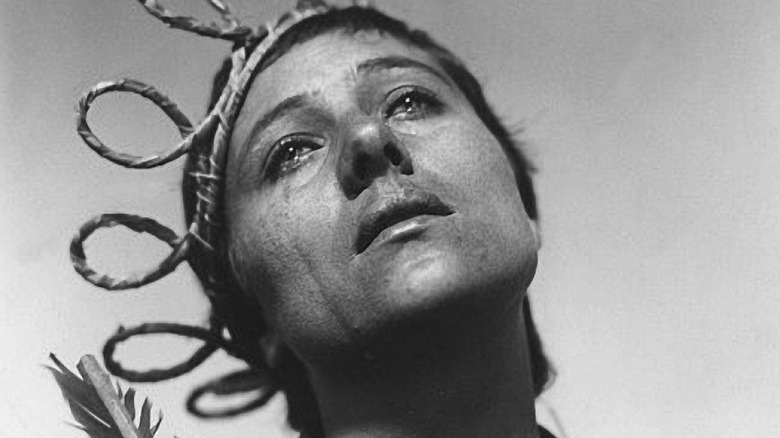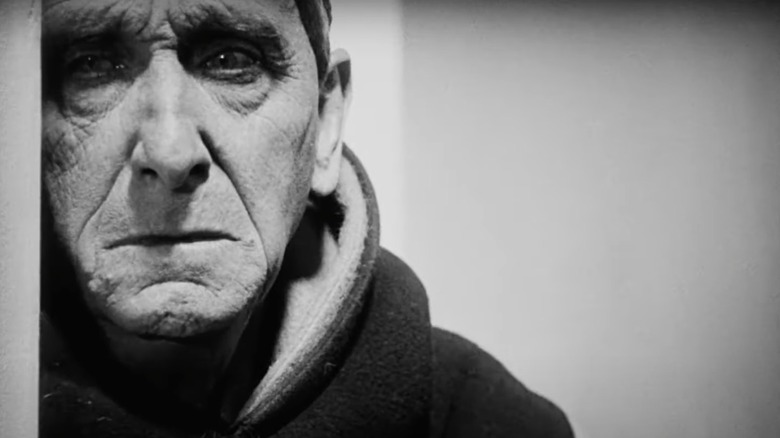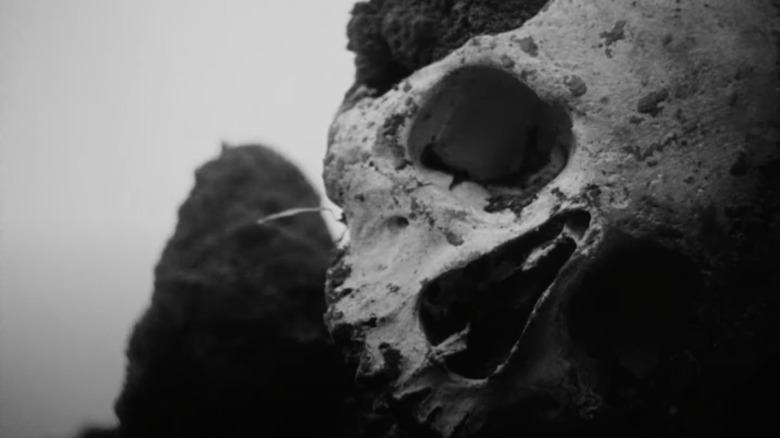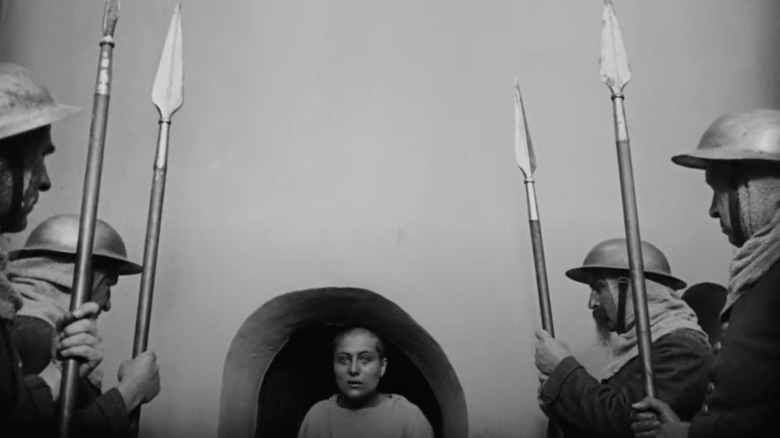The Daily Stream: The Passion Of Joan Of Arc Is Potent As Ever
(Welcome to The Daily Stream, an ongoing series in which the /Film team shares what they've been watching, why it's worth checking out, and where you can stream it.)
The Movie: "The Passion of Joan of Arc"
Where You Can Stream It: HBO Max, The Criterion Channel
The Pitch: "The Passion of Joan of Arc" is one of those films that pitches itself right at the outset, as text informs the viewer that a library in Paris "holds one of the most extraordinary documents in the history of the world" — a record of the trial of the 15th-century French martyr Joan of Arc, who was famously burned at the stake for heresy, only to later be sainted. As the text explains:
"The judges' questions and Joan's answers are meticulously recorded. Reading it, we discover Joan as she really was. Not the Joan in helmet and armor, but simple and human."
"Simple and human" are key words to understanding the enduring appeal of Carl Theodor Dreyer's 1928 silent classic, which unfolds as a reenactment based on those court records, and which continues to influence movies like "The Green Knight." It marks a monumental performance (one of only two on film) from the French stage actress Renée Jeanne Falconetti.
Even if you've never seen "The Passion of Joan of Arc," you may have absorbed the ineradicable image of Falconetti's unblinking face, by turns wide-eyed and dolorous, as her character, the 19-year-old village-girl-turned-warrior, "Joanie," meets her accusers and wears her twisted straw crown. Roger Ebert began his Great Movies review of the film with the ultimatum, "You cannot know the history of silent film unless you know the face of Renée Maria Falconetti."
Why it's essential viewing
Among other things, "The Passion of Joan of Arc" ranked #9 on the BFI's 2012 critics' list of the 100 greatest films of all time. It will be interesting to see where it lands this year when the once-a-decade poll determining that list comes back around. In his nominations for the directors' list, Michael Mann wrote, "Human experience conveyed purely from the visualization of the human face: no one else has composed and realized human beings quite like Dreyer in The Passion of Joan of Arc."
In an age of deepfakes and digitally de-aged actors — where every character from "The Irishman" to "She-Hulk" seems stuck in the uncanny valley — "The Passion of Joan of Arc" serves as a reminder that the real human face, even without makeup, stands the test of time better than any misbegotten VFX rendering. It's not just Falconetti's face; there's a constant back-and-forth of close-ups between her and the judges overseeing her trial and other participants like the canon Nicolas Loyseleur (Maurice Schutz).
The movie's title draws a direct connection between Joan's final hours and the biblical Passion Play. Joan believes she's God's daughter, that she was born to save France, and that she'll be freed from her English prison "through a great victory." Echoing Christ's words, she says she knows "neither the day nor the hour" of when she'll be freed — and we understand that being "freed" for her means shuffling off this mortal coil.
For Joan, life is the vestibule; death is the door. The "great victory" is her martyrdom. We see her drawing comfort from a window's cross-shaped shadow, and as she goes to her Calvary, we see her clutching a cross and asking if she will be in paradise with God tonight.
Hints of horror to come
There's a scene in "The Passion of Joan of Arc" in which Joan is led into a chamber, where an audience of men gather and various torture implements are teased. Throughout the film, these men spit on Joan, ask her why she dresses like a man, and delight in tormenting her. Loyseleur feigns compassion, forging a letter from the king and taking advantage of Joan's inability to read (later, guiding her hand and practically signing her own confession for her). There's also one legitimate conscientious objector, which again aligns Joan with Christ and accounts of the Pharisee Nicodemus.
The sight of the torture wheel works Joan up into a swoon, and she is soon taken out of the chamber, so that we never really see her undergo torture there. Yet it's as if that chamber sets the stage for other cinematic horrors, religious and otherwise, for decades to come.
Rudolph Maté's cinematography, the close-ups that bring out the lines in characters' faces in "The Passion of Joan of Arc," prefigures that of Jack Cardiff in "Black Narcissus." The fly that keeps landing on Joan's face anticipates the one on the leering countenance of Norman Bates at the end of "Psycho." As Joan's head is shaved for her execution, she begins to resemble another unlikely Christ figure, Ellen Ripley in "Alien 3," while her execution becomes a literal circus, with contortionists and sword swallowers performing for the crowd, and a baby looking up, half-interested, from the extreme-close-up nipple on which it's breast-feeding.
And of course, there are parallels to the circus-sideshow horror of "The Passion of the Christ," which hit theaters eight months before "Saw" and can perhaps be seen as the real beginning of the 2000s torture-porn craze.
Silence is golden
By its nature as a silent film, "The Passion of Joan of Arc" shows how unnecessary some dialogue is. The selective use of intertitles leaves us with moments where we see characters moving their lips but are left to infer what they're saying or absorb the emotional gist of it without hearing.
When Joan realizes her confession is tantamount to an act of apostasy and recants, her agony in the flames provides a discomfiting reminder that actual physical torture was a spectator event long before the rise of torture porn. Better to go out in a blaze of glory than be subject to a life of "perpetual imprisonment with the bread of sorrow and the water of affliction."
"The Passion of Joan of Arc" puts focus, not just on Joan's death, but on the violence that erupts as members of the crowd clash with authorities, who have just burned a living saint. The film's path to preservation was fraught with real fires, which destroyed the original negatives, as if it were Joan herself and acts of God sought to dictate which version of it would survive. That Dreyer's original cut was later found in a janitor's closet in a mental hospital may only invite further reflection on the idea of the bicameral mind (more than just the "Westworld" season 1 finale title.)
In the 21st century, a woman like Joan might be viewed as disturbed, per "Saint Maud." The turn-of-the-millennium film "The Messenger: The Story of Joan of Arc," notably left her to tango with her own godlike "Conscience" at the end rather than a true supreme being, per se. The rest of us are left to tango with Dreyer's film, which remains as affecting and thought-provoking now as it ever was.



